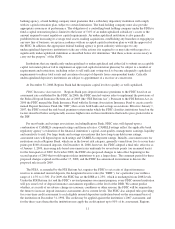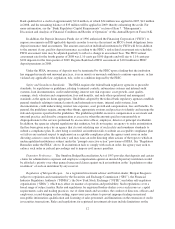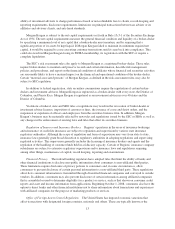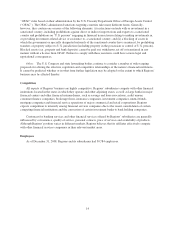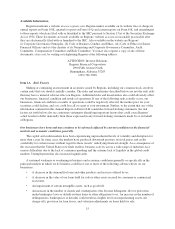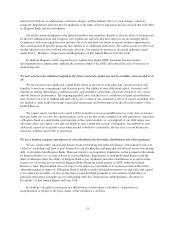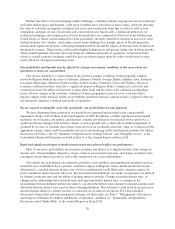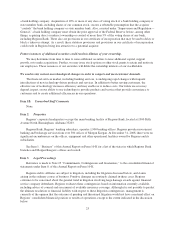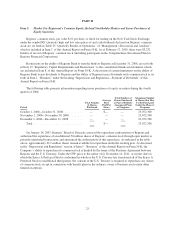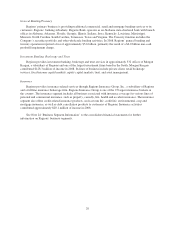Regions Bank 2008 Annual Report Download - page 29
Download and view the complete annual report
Please find page 29 of the 2008 Regions Bank annual report below. You can navigate through the pages in the report by either clicking on the pages listed below, or by using the keyword search tool below to find specific information within the annual report.Any reduction in our credit rating could increase the cost of our funding from the capital markets.
The major rating agencies regularly evaluate us and their ratings of our long-term debt based on a number of
factors, including our financial strength as well as factors not entirely within our control, including conditions
affecting the financial services industry generally. On February 2, 2009, Moody’s Investors Service (“Moody’s”)
downgraded our long-term senior debt from A2 to A3, and downgraded the ratings of certain of our subsidiaries,
including Regions Bank. Moody’s downgraded its rating of Regions Bank’s financial strength from B- to C+ and
its rating of Regions Bank’s long-term deposits from A1 to A2 and all of our debt and deposit ratings remain on
negative outlook. In light of the difficulties in the financial services industry and the housing and financial
markets, there can be no assurance that we will not be subject to further downgrades. Credit ratings measure a
company’s ability to repay its obligations and directly affect the cost and availability to that company of
unsecured financing. Further downgrades could adversely affect the cost and other terms upon which we are able
to obtain funding and increase our cost of capital.
We may not pay dividends on your common stock.
Holders of shares of our common stock are only entitled to receive such dividends as our board of directors
may declare out of funds legally available for such payments. Although we have historically declared cash
dividends on our common stock, we are not required to do so and may reduce or eliminate our common stock
dividend in the future. This could adversely affect the market price of our common stock. Also, participation in
the CPP limits our ability to increase our dividend or to repurchase our common stock for so long as any
securities issued under such program remain outstanding, as discussed in greater detail below.
If we experience greater credit losses than anticipated, our earnings may be adversely affected.
As a lender, we are exposed to the risk that our customers will be unable to repay their loans according to
their terms and that any collateral securing the payment of their loans may not be sufficient to assure repayment.
Credit losses are inherent in the business of making loans and could have a material adverse effect on our
operating results. Our credit risk with respect to our real estate and construction loan portfolio will relate
principally to the creditworthiness of corporations and the value of the real estate serving as security for the
repayment of loans. Our credit risk with respect to our commercial and consumer loan portfolio will relate
principally to the general creditworthiness of businesses and individuals within our local markets.
We make various assumptions and judgments about the collectibility of our loan portfolio and provide an
allowance for estimated credit losses based on a number of factors. We believe that our allowance for credit
losses is adequate. However, if our assumptions or judgments are wrong, our allowance for credit losses may not
be sufficient to cover our actual credit losses. We may have to increase our allowance in the future in response to
the request of one of our primary banking regulators, to adjust for changing conditions and assumptions, or as a
result of any deterioration in the quality of our loan portfolio. The actual amount of future provisions for credit
losses cannot be determined at this time and may vary from the amounts of past provisions.
Further disruptions in the residential real estate market could adversely affect our performance.
As of December 31, 2008, residential homebuilder loans, home equity loans secured by second liens in
Florida and condominium loans represented approximately 9.3% of our total loan portfolio. These portions of our
loan portfolio have been under stress for over a year and, due to weakening credit quality, we increased our loan
loss provision and our total allowance for credit losses. In addition, we have implemented several measures to
support the management of these portions of the loan portfolio, including reassignment of experienced, key
relationship managers to focus on work-out strategies for distressed borrowers.
While we expect that these actions will help mitigate the overall effects of the credit down cycle, the
weakness in these portions of our loan portfolio is expected to continue well into 2009. Accordingly, it is
anticipated that our non-performing asset and charge-off levels will remain elevated.
19




